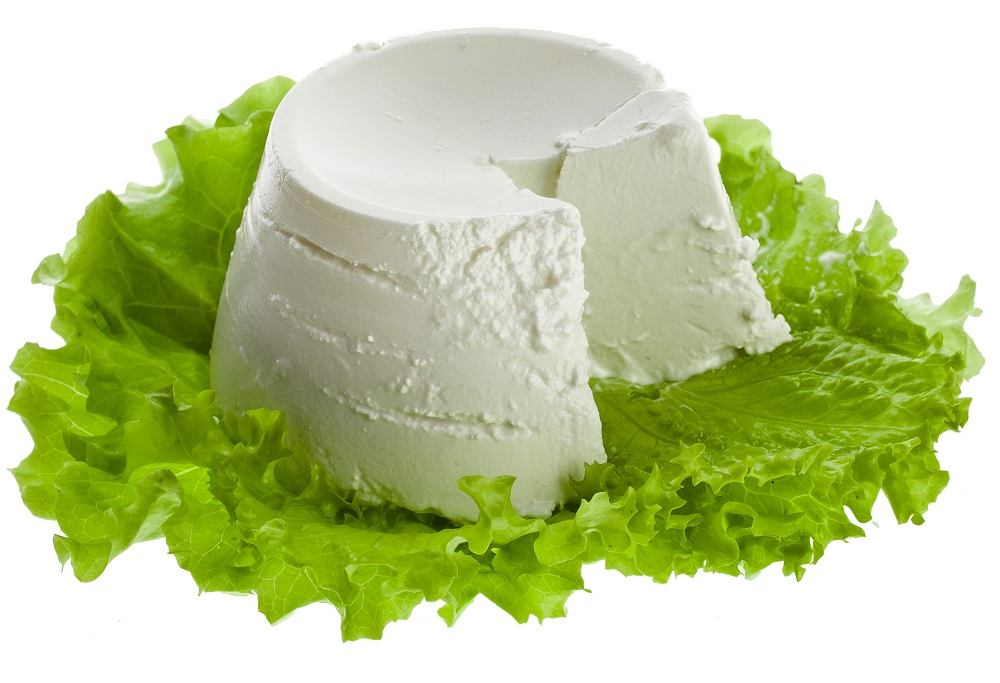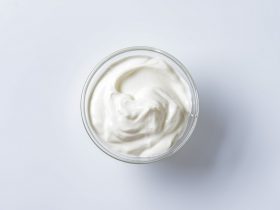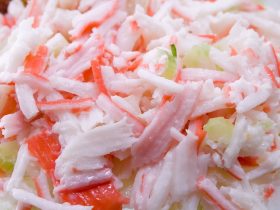Ricotta is a versatile type of cheese that is used in various dishes and can also be eaten on its own. It is soft, fluffy, spreadable, and has a mild flavor. A lot of soft cheeses are unsafe for pregnant women to eat. But is ricotta cheese one of them?
Ricotta cheese is safe to eat during pregnancy, as long as it was made from pasteurized milk, like most commercially available brands. Homemade and artisanal types of ricotta may need to be rechecked. Cooking or baking ricotta also make it safe for consumption by pregnant women.
Jesmarie Macapagal, RN, MD, DPPS
What is Ricotta Cheese?
Ricotta is a general term that is used to identify a variety of Italian whey cheeses (Scarano et al., 2019). It is a fresh cheese that is light, spongy and creamy. “Ricotta” in Italian translates to “recooked” in English.
In contrast to most cheeses that are made from milk curds, ricotta is traditionally made from milk whey with the few curds that are left behind. Whey is the fluid portion obtained by separation from the curd after coagulation of milk during the manufacture of cheese (Scarano et al., 2019). After the curds are made into any cheese that a cheesemaker wants, the leftover whey is then repurposed to create ricotta.
Ricotta cheese production is, thus, one of the most applicable ways of reusing cheese whey that were leftover from cheesemaking. Ricotta can be produced from sheep milk, goat milk, a mixture of cheese whey and milk (Wu et al., 2020), or water buffalo milk. However, commercial ricotta is most often made from cow’s milk.

The traditional method of making ricotta involves heating the whey, after adding a small amount of whole milk and some vinegar, citrus juice or rennet, to make the remaining curds coagulate. The curds eventually become larger and more solid, then the pot is emptied into a cheesecloth and strained. The finished product is a fluffy, white ricotta.
In industrial plants, the whey is filtered, heated to 65 degrees Celsius and sent to storage tanks. It is then transferred to large open kettles, where steam or indirect heating rises the temperature to 80 degrees Celsius. This mixture is held for 15 to 20 minutes as the proteins aggregate and start floating on the whey surface (Pala et al., 2016).
The clumped proteins are collected and placed into baskets to drain. The baskets are then placed in cold rooms, with a temperature of 2 to 4 degrees Celsius, where they are made to drain further and rapidly cool down within 12 hours (Pala et al., 2016).
The average composition of ricotta is 70 to 80 percent moisture, 10 to 25 percent fat and 8 to 10 percent protein. Ricotta can be wrapped in food paper or placed in modified atmosphere packaging. It can be consumed as it is or added as ingredient in various dishes (Pala et al., 2016).
However, nowadays, especially in the United States, ricotta is being made from whole milk instead of whey. The same process is completed, with the whole milk heated to coagulate, then strained to separate the curds and produce a soft, fresh, spreadable cheese.
Ricotta cheese, being a soft whey cheese that is high in moisture with a pH lower than 6.0, is also highly susceptible to microbial spoilage and has a limited shelf life even when refrigerated (Wu et al., 2020). Because ricotta is not aged in any way, it remains light and moist, and is more perishable than hard cheeses.
Fresh ricotta is usually added in dollops to dishes or stuffed into pasta. It is often used as ingredient in lasagna and other Italian casseroles. It is also a common stuffing for ravioli, manicotti and other pasta dishes. It can be used to fill cannoli or as a layer cake filling. It can be used in omelets and quiche. In Italy, it is popularly enjoyed as spread on toast with honey, and pairs particularly well with fresh figs.
Risks of Eating Ricotta Cheese While Pregnant
The composition and intrinsic properties of ricotta, coupled with the absence of preservatives in its production, make this product an excellent substrate for the growth of spoilage and pathogenic microorganisms (Pala et al., 2016). Ricotta cheese is an excellent medium for growth of Pseudomonas species, yeasts, molds, and Enterobacteriaceae (Ricciardi et al., 2020).
There is increased risk of contamination after the curd aggregation process. During molding, chilling and packaging, the cheese is held in environments that are not always supplied with sufficient hygienic protection systems like air filtration (Kousta et al., 2010).
During cold storage of whey cheeses, different microorganisms are able to grow, including coliforms, Staphylococci and Bacillus cereus (Pintado & Malcata, 2000). Bacillus cereus grows favorably in the temperature range between 40 and 10 degrees Celsius (Soni et al., 2016). The cooling phase after heat treatment of ricotta represents a likely step where recontamination can occur (Ricciardi et al., 2020).
Listeriosis
Listeriosis is a severe food borne disease caused by Listeria monocytogenes. In pregnant women, listeriosis usually manifests as a nonspecific febrile illness. However, it can result in fetal loss, premature labor, and neonatal sepsis and meningitis (Heiman et al., 2016).
In the United States alone, an estimated 1600 invasive cases of listeriosis occur every year (Scallan et al., 2011). Majority of these invasive infections occur in specific population groups, including pregnant women and newborn babies, who typically present with bacteremia or meningitis. Death ensues in about 21 percent of cases (Silk et al., 2013).
In 2012, a multistate outbreak of listeriosis happened in the United States. Twenty two cases were reported, including four deaths and one fetal loss. Packages of imported ricotta salata were found to yield the outbreak strain. Other cheeses were also found to be cross-contaminated (Heiman et al., 2016).
Pasteurized vs Unpasteurized Ricotta Cheese
The public health benefits of the process of milk pasteurization are well established. Pasteurization ensures safety for human consumption of milk (Macdonald et al., 2011). Majority of the brands of ricotta cheese that are available in supermarkets are made using pasteurized milk, and are safe for pregnant women to consume.
The definition of pasteurization is “the process of heating every particle of milk or milk product, in properly designed and operated equipment, to any 1 of the specified pasteurization time / temperature combinations” for the purpose of destroying all human pathogens. The most common pasteurization method is rapidly heating milk to at least 72 degrees Celsius and maintaining that temperature for a minimum of 15 seconds (Lucey, 2015).
Raw milk becomes contaminated by pathogenic organisms through different mechanisms, including direct passage from the blood into the milk of an animal, mastitis, fecal contamination, or contamination from human skin (Lucey, 2015).
Unpasteurized milk can become contaminated with Listeria monocytogenes even before the process of cheesemaking. Cows, sheep and goats can shed the bacterium through their milk. Fecal contamination can also occur during milking (Heiman et al., 2016).
Arcobacter butzleri has been isolated in artisanal ready to eat (RTE) water buffalo ricotta cheese. Arcobacter species have been reported in different steps of the dairy chain from fecal samples of dairy animals, milk filters and raw milk (Scarano et al., 2014). Arcobacter butzleri has been associated with several cases of gastrointestinal disease, and persistent diarrhea is the main symptom in humans (Collado & Figueras, 2011).
Eating Ricotta During Pregnancy
According to the UK National Health Service (NHS), the following types of cheese are safe to eat during pregnancy:
- All hard cheeses like cheddar, Stilton and parmesan
- Pasteurized soft cheeses like cottage cheese, mozzarella, feta, cream cheese, paneer, halloumi, goat’s cheese without rind, processed cheese spreads, and ricotta
- Unpasteurized and all other cheeses that were thoroughly cooked until steaming hot
- Pasteurized milk, yogurt, cream and ice cream
In contrast, these cheeses are recommended by the NHS to be avoided during pregnancy:
- Mold-ripened soft cheeses like brie, camembert and chèvre that were not cooked
- Soft blue cheeses like Danish blue, gorgonzola and Roquefort that were not cooked
- Any unpasteurized cheese or milk
However, according to the NSW Food Authority from Australia, soft and semi-soft cheeses should not be consumed during pregnancy, unless they were thoroughly cooked to a minimum temperature of 75 degrees Celsius. These include brie, camembert, feta, blue cheese, and ricotta.
To make unpasteurized ricotta safe to eat, pregnant women can cook them to a temperature of 165 degrees Fahrenheit (or 74 degrees Celsius) or heat them until steaming hot. Use a food thermometer to accurately measure the internal temperature.
Tips for Eating Ricotta During Pregnancy
- When homemade from pasteurized milk, eat fresh ricotta immediately after making it.
- When bought from a grocery store, choose ricotta that is not near the expiration date and eat it immediately after opening
- Wrap securely and store unfinished ricotta in the refrigerator
- If ricotta looks or smells off and you are in doubt about its safety, do not eat it and throw it out
- Cook or bake ricotta until a temperature of 165 degrees Fahrenheit has been reached to kill any potential pathogen like Listeria.
Ricotta is highly perishable. Therefore, it must be kept in the refrigerator in a tightly closed container. Once opened, it should be consumed within 5 to 7 days. Ricotta can also be safely frozen for up to six months, but must be slowly defrosted in the refrigerator before consumption.
Final Thoughts
Ricotta cheese can be stuffed into ravioli, dropped on top of a pizza, or mixed in desserts. When made from pasteurized milk, ricotta can be a safe addition to your diet during pregnancy. However, avoid the artisanal or homemade varieties that may have used raw milk.
To make it extra safe to eat, ricotta can be cooked to a safe temperature. This should not be a problem since most ricotta appears in cooked dishes anyway.
For the best advice regarding cheese consumption during pregnancy, consult your obstetrician or dietitian. They can give you an individualized approach to all your pregnancy diet needs.
References
- https://www.bonappetit.com/story/what-is-ricotta-cheese
- https://www.thespruceeats.com/ricotta-cheese-recipes-and-cooking-tips-1802376
- https://www.healthline.com/health/pregnancy/is-ricotta-cheese-safe#:~:text=Most%20ricotta%20cheese%20you’ll,safe%20to%20eat%20during%20pregnancy.
- https://www.nhs.uk/pregnancy/keeping-well/foods-to-avoid/
- https://www.foodauthority.nsw.gov.au/consumer/life-events-and-food/pregnancy/foods-to-eat-or-avoid-when-pregnant
- Collado, L., & Figueras, M. J. (2011). Taxonomy, epidemiology, and clinical relevance of the genus Arcobacter. Clinical Microbiology Reviews 24(1), 174-192. doi: 10.1128/CMR.00034-10
- Heiman, K. E., Garalde, V. B., Gronostaj, M., Jackson, K. A., Beam, S., Joseph, L., …, & Silk, B. J. (2016). Multistate outbreak of listeriosis caused by imported cheese and evidence of cross-contamination of other cheeses, USA, 2012. Epidemiology and Infection 144(13), 2698-2708. doi: 10.1017/S095026881500117X
- Kousta, M., Mataragas, M., Skandamis, P., & Drosinos, E. (2010). Prevalence and sources of cheese contamination with pathogens at farm and processing levels. Food Control 21(6), 805-815. https://doi.org/10.1016/j.foodcont.2009.11.015
- Lucey, J. (2015). Raw milk consumption: Risks and benefits. Nutrition Today 50(4), 189-193. doi: 10.1097/NT.0000000000000108
- Macdonald, L., Brett, J., Kelton, D., Majowicz, S., Snedeker, K., & Sargeant, J. (2011). A systematic review and meta-analysis of the effects of pasteurization on milk vitamins, and evidence for raw milk consumption and other health-related outcomes. Journal of Food Protection 74(11), 1814-1832. doi: 10.4315/0362-028X.JFP-10-269
- Pala, C., Scarano, C., Venusti, M., Sardo, D., Casti, D., Cossu, F., …, & De Santis, E. P. (2016). Shelf life evaluation of ricotta fresca sheep cheese in modified atmosphere packaging. Italian Journal of Food Safety 5(3), 5502. doi: 10.4081/ijfs.2016.5502
- Pintado, M. E., & Malcata, F. X. (2000). Characterization of whey cheese packaged under vacuum. Journal of Food Protection 63(2), 216-221. doi: 10.4315/0362-028x-63.2.216
- Ricciardi, E. F., Pedros-Garrido, S., Papoutsis, K., Lyng, J., Conte, A., & Del Nobile, M. (2020). Novel technologies for preserving ricotta cheese: Effects of ultraviolet and near-ultraviolet-visible light. Foods 9(5), 580. doi: 10.3390/foods9050580
- Scallan, E., Hoekstra, R., Angulo, F., Tauxe, R., Widdowson, M. A., Roy, S., …, & Griffin, P. (2011). Foodborne illness acquired in the United States: Major pathogens. Emerging Infectious Diseases 17(1), 7-15. doi: 10.3201/eid1701.p11101
- Scarano, C., Giacometti, F., Manfreda, G., Lucchi, A., Pes, E., Spanu, C., …, & Serraino, A. (2014). Arcobacter butzleri in sheep ricotta cheese at retail and related sources of contamination in an industrial dairy plant. Applied and Environmental Microbiology 80(22), 7036-7041. doi: 10.1128/AEM.02491-14
- Scarano, C., Spanu, C., Mocci, A. M., Piras, F., Demontis, M., Murittu, G., …, & De Santis, E. P. (2019). Microbiological and physicochemical properties of smoked ricotta cheese during refrigeration and temperature abuse storage. Italian Journal of Food Safety 8(2), 8009. doi: 10.4081/ijfs.2019.8009
- Silk, B., Mahon, B., Griffin, P., Gould, L. H., Tauxe, R., Crim, S., …, & Henao, O. (2013). Vital signs: Listeria illnesses, deaths, and outbreaks: United States, 2009-2011. MMWR: Morbidity and Mortality Weekly Report 62(22), 448-452. https://www.ncbi.nlm.nih.gov/pmc/articles/PMC4604984/
- Soni, A., Oey, I., Silcock, P., & Bremer, P. (2016). Bacillus spores in the food industry: A review on resistance and response to novel inactivation technologies. Comprehensive Reviews in Food Science and Food Safety 15(6), 1139-1148. https://doi.org/10.1111/1541-4337.12231
- Wu, C. S., Guo, J. H., & Lin, M. J. (2020). Stability evaluation of pH-adjusted goat milk for developing ricotta cheese with a mixture of cow cheese whey and goat milk. Foods 9(3), 366. doi: 10.3390/foods9030366




